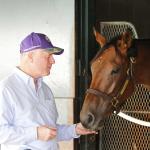
Noel’s Weekend Winners: Wide-Open Saturday Stakes at Fair Grounds

Stakes races like the Belmont or the Woodward stand as tributes to those who make significant contributions to horse racing, their names reflective of what those Pillars of the Turf have given the sport.

Run annually at Saratoga Race Course, the Whitney Stakes and its roster of winners, including a Triple Crown winner and a slew of Hall of Famers, recognize what the family’s multiple generations of owners and breeders have given the sport in the years since William Collins Whitney bought his first Thoroughbred.
Inaugurated in 1928, the Whitney Stakes has become an annual reminder of what the name Whitney represents in the history of American racing, a tradition of excellence reflected in the champions who have taken this rich feature.
A Family of Import
Now a “Win and You’re In” Challenge Series qualifying race for the Longines Breeders’ Cup Classic, the Grade 1 Whitney was added to Saratoga’s 1928 stakes schedule as a tribute to the late William Payne Whitney, younger son of William Collins Whitney and owner of Greentree Stable.
The younger Whitney had died suddenly the previous summer, his death mourned by the New York racing society who lowered the flag at Belmont Park to half-staff in his honor. Naming the 1 ¼-mile stakes for the late owner also recognized the role that the family played in the sport in the first half of the 20th century, starting with patriarch William Collins Whitney.
The elder Whitney had a successful career as a businessman and politician, where he served as Secretary of the Navy under President Grover Cleveland, before investing in both racing and breeding thanks to friends John E. Madden and August Belmont II. He bred 26 champions, including the Hall of Fame filly Artful, and won the 1901 Epsom Derby with Volodyovski. The patriarch also helped revive Saratoga Race Course as part of the Saratoga Association for the Improvement of the Breed of Horses, a syndicate that also included Richard T. Wilson and Thomas Hitchcock.

Both of his sons, Harry Payne and William Payne, followed their father into the sport, the latter with his wife, Helen Hay Whitney, daughter of John Hay, former politician and ambassador to the United Kingdom. Though he had dabbled in racing before his father’s 1904 death, Harry Payne solidified his investment in the sport with his purchase of 16 mares and two stallions from his father’s bloodstock. He then turned to racing and breeding, his Eton blue and brown colors becoming a common sight at the country’s racetracks, including in the 1915 Kentucky Derby winner’s circle when Regret became the first filly to win the big race. William Payne’s involvement in The Jockey Club was initially more of a social and business obligation, but thanks to Helen’s influence, the couple started racing as Greentree Stable in the 1910s, winning the Kentucky Oaks with Untidy in 1923.
By the time William Payne Whitney died in May 1927, more than two decades after his father, the Whitneys had become part of the sport’s elite. Bestowing the family’s name upon a stakes race at Saratoga, a racetrack rescued by William Collins Whitney and patronized by the family’s various stables, became more than a memorial for one man. This yearly prize honors the Whitney family’ role in the sport and serves as a chance for the best that the sport has to offer to display their talent in the brightest of spotlights.
A Significant Test
The first Whitney Stakes featured a short field of four, including 1927 Kentucky Derby winner Whiskery; Chance Shot, the previous year’s Belmont Stakes victor; an outsider named Friar’s Hope; and the William R. Coe mare Black Maria. Whiskery led for much of the ten furlongs but gave way inside the final eighth as Black Maria made her bid for the lead. She held off Chance Shot to win by a half-length, the first of six fillies to win the Whitney, followed by Bateau (1929), Esposa (1937), Gallorette (1948), Lady’s Secret (1986), and Personal Ensign (1988).

Initially open to 3-year-olds and older, the race was shortened from 1 ¼ miles to 1 1/8 miles in 1955 and then restricted to 4 -year-olds and older from 1957 to 1969 and then again starting in 2020. The Grade 1 race became part of the “Win and You’re In” path to the Breeders’ Cup Classic in 2007. Since then, five Whitney winners have also won the Classic, including Gun Runner (2017) and Knicks Go (2021), both of whom were later named Horse of the Year.
Since its inception nearly a century ago, the Whitney has played host to quite a few of the sport’s greats. In the race’s first decade, Alfred G. Vanderbilt II’s Discovery won three consecutive editions, 1934-1936, and then Kelso equaled that mark with his wins in 1961, 1963, and 1965. War Admiral won the Whitney the year after his 1937 Triple Crown sweep, but Secretariat tasted defeat in the 1973 edition, when the Allen Jerkens-trained Onion surprised everyone by taking the lead from the break and then going gate to wire to beat the ailing Triple Crown winner by a length.